HND Business Unit 5: Accounting Principles Assignment - Semester 1
VerifiedAdded on 2023/02/13
|32
|5757
|32
Homework Assignment
AI Summary
This assignment solution covers the application of accounting principles within the context of a Higher National Diploma (HND) in Business program. The assignment is divided into several sections, including a blog post analyzing the role of accounting within an organization, evaluating its purpose, scope, branches, and the influence of technology, ethics, and regulations. Another section involves the preparation of budgetary reports, including sales, production, and cash budgets for a hypothetical business, Tools Ltd. The assignment also requires the construction of financial statements, specifically an income statement and a statement of financial position, along with the calculation and interpretation of financial ratios. Finally, it includes the drafting of a detailed letter to a client, demonstrating the ability to communicate accounting information effectively. The solution addresses topics such as the accounting function, financial statement preparation, budgetary control, and interpretation, aligning with the learning outcomes of the unit and demonstrating practical application of accounting concepts.
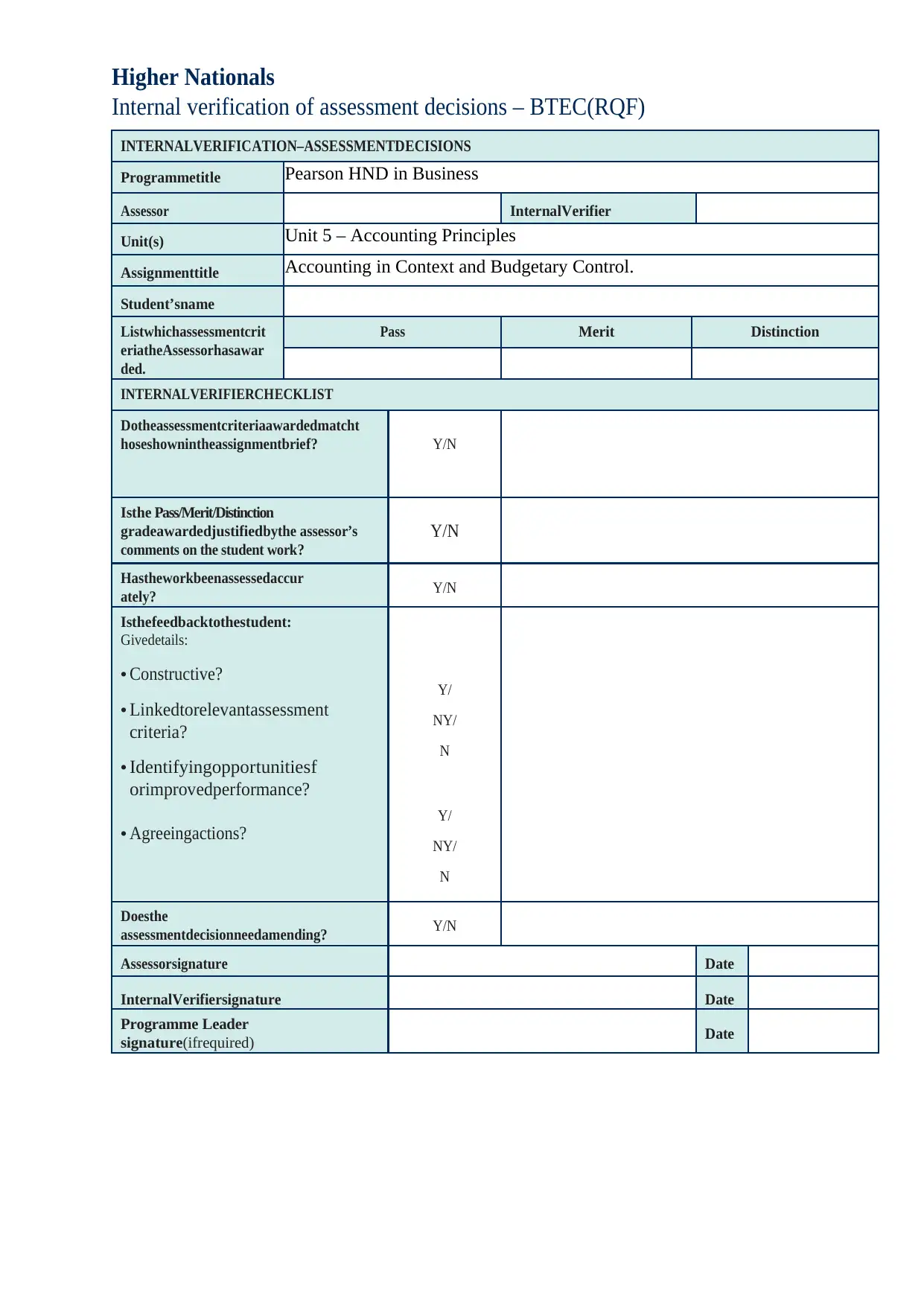
Higher Nationals
Internal verification of assessment decisions – BTEC(RQF)
INTERNALVERIFICATION–ASSESSMENTDECISIONS
Programmetitle Pearson HND in Business
Assessor InternalVerifier
Unit(s) Unit 5 – Accounting Principles
Assignmenttitle Accounting in Context and Budgetary Control.
Student’sname
Listwhichassessmentcrit
eriatheAssessorhasawar
ded.
Pass Merit Distinction
INTERNALVERIFIERCHECKLIST
Dotheassessmentcriteriaawardedmatcht
hoseshownintheassignmentbrief? Y/N
Isthe Pass/Merit/Distinction
gradeawardedjustified bythe assessor’s
comments on the student work?
Y/N
Hastheworkbeenassessedaccur
ately? Y/N
Isthefeedbacktothestudent:
Givedetails:
• Constructive?
• Linkedtorelevantassessment
criteria?
• Identifyingopportunitiesf
or improvedperformance?
• Agreeingactions?
Y/
NY/
N
Y/
NY/
N
Doesthe
assessmentdecisionneedamending? Y/N
Assessorsignature Date
InternalVerifiersignature Date
Programme Leader
signature(ifrequired) Date
Internal verification of assessment decisions – BTEC(RQF)
INTERNALVERIFICATION–ASSESSMENTDECISIONS
Programmetitle Pearson HND in Business
Assessor InternalVerifier
Unit(s) Unit 5 – Accounting Principles
Assignmenttitle Accounting in Context and Budgetary Control.
Student’sname
Listwhichassessmentcrit
eriatheAssessorhasawar
ded.
Pass Merit Distinction
INTERNALVERIFIERCHECKLIST
Dotheassessmentcriteriaawardedmatcht
hoseshownintheassignmentbrief? Y/N
Isthe Pass/Merit/Distinction
gradeawardedjustified bythe assessor’s
comments on the student work?
Y/N
Hastheworkbeenassessedaccur
ately? Y/N
Isthefeedbacktothestudent:
Givedetails:
• Constructive?
• Linkedtorelevantassessment
criteria?
• Identifyingopportunitiesf
or improvedperformance?
• Agreeingactions?
Y/
NY/
N
Y/
NY/
N
Doesthe
assessmentdecisionneedamending? Y/N
Assessorsignature Date
InternalVerifiersignature Date
Programme Leader
signature(ifrequired) Date
Paraphrase This Document
Need a fresh take? Get an instant paraphrase of this document with our AI Paraphraser
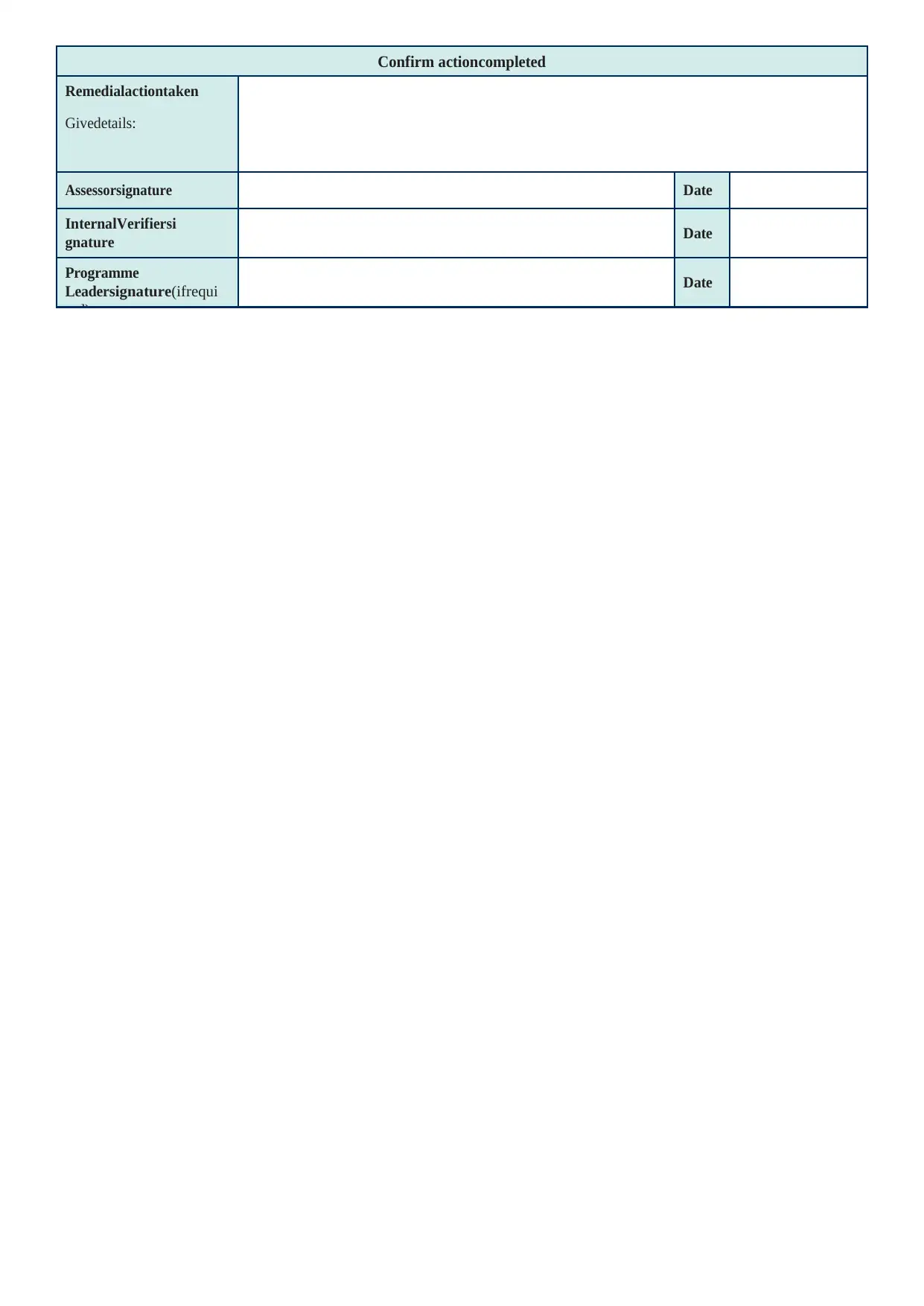
Confirm actioncompleted
Remedialactiontaken
Givedetails:
Assessorsignature Date
InternalVerifiersi
gnature Date
Programme
Leadersignature(ifrequi
red)
Date
Remedialactiontaken
Givedetails:
Assessorsignature Date
InternalVerifiersi
gnature Date
Programme
Leadersignature(ifrequi
red)
Date
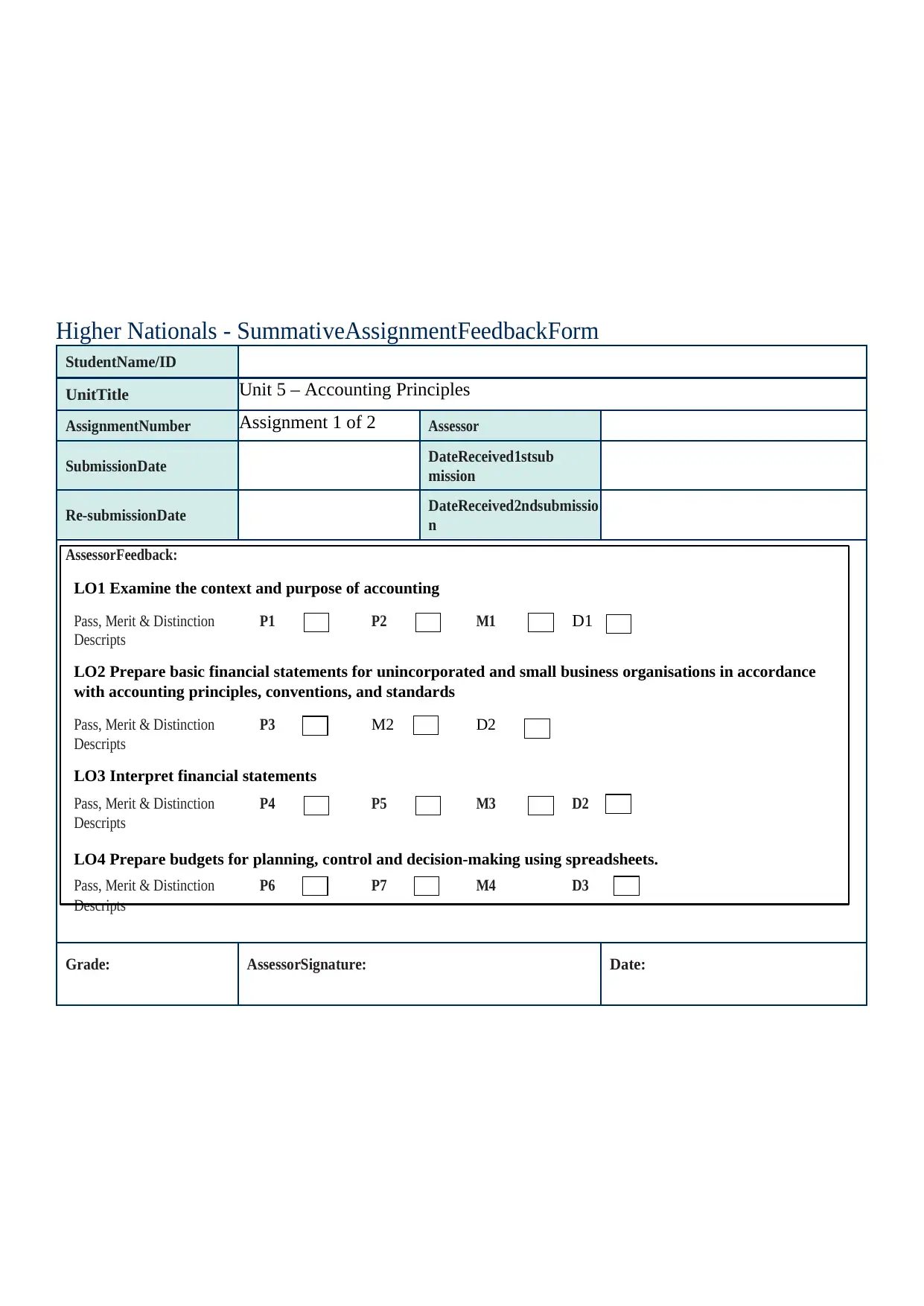
Higher Nationals - SummativeAssignmentFeedbackForm
StudentName/ID
UnitTitle Unit 5 – Accounting Principles
AssignmentNumber Assignment 1 of 2 Assessor
SubmissionDate DateReceived1stsub
mission
Re-submissionDate DateReceived2ndsubmissio
n
AssessorFeedback:
LO1 Examine the context and purpose of accounting
Pass, Merit & Distinction
Descripts
P1 P2 M1 D1
LO2 Prepare basic financial statements for unincorporated and small business organisations in accordance
with accounting principles, conventions, and standards
Pass, Merit & Distinction
Descripts
P3 M2 D2
LO3 Interpret financial statements
Pass, Merit & Distinction
Descripts
P4 P5 M3 D2
LO4 Prepare budgets for planning, control and decision-making using spreadsheets.
Pass, Merit & Distinction
Descripts
P6 P7 M4 D3
Grade: AssessorSignature: Date:
StudentName/ID
UnitTitle Unit 5 – Accounting Principles
AssignmentNumber Assignment 1 of 2 Assessor
SubmissionDate DateReceived1stsub
mission
Re-submissionDate DateReceived2ndsubmissio
n
AssessorFeedback:
LO1 Examine the context and purpose of accounting
Pass, Merit & Distinction
Descripts
P1 P2 M1 D1
LO2 Prepare basic financial statements for unincorporated and small business organisations in accordance
with accounting principles, conventions, and standards
Pass, Merit & Distinction
Descripts
P3 M2 D2
LO3 Interpret financial statements
Pass, Merit & Distinction
Descripts
P4 P5 M3 D2
LO4 Prepare budgets for planning, control and decision-making using spreadsheets.
Pass, Merit & Distinction
Descripts
P6 P7 M4 D3
Grade: AssessorSignature: Date:
⊘ This is a preview!⊘
Do you want full access?
Subscribe today to unlock all pages.

Trusted by 1+ million students worldwide
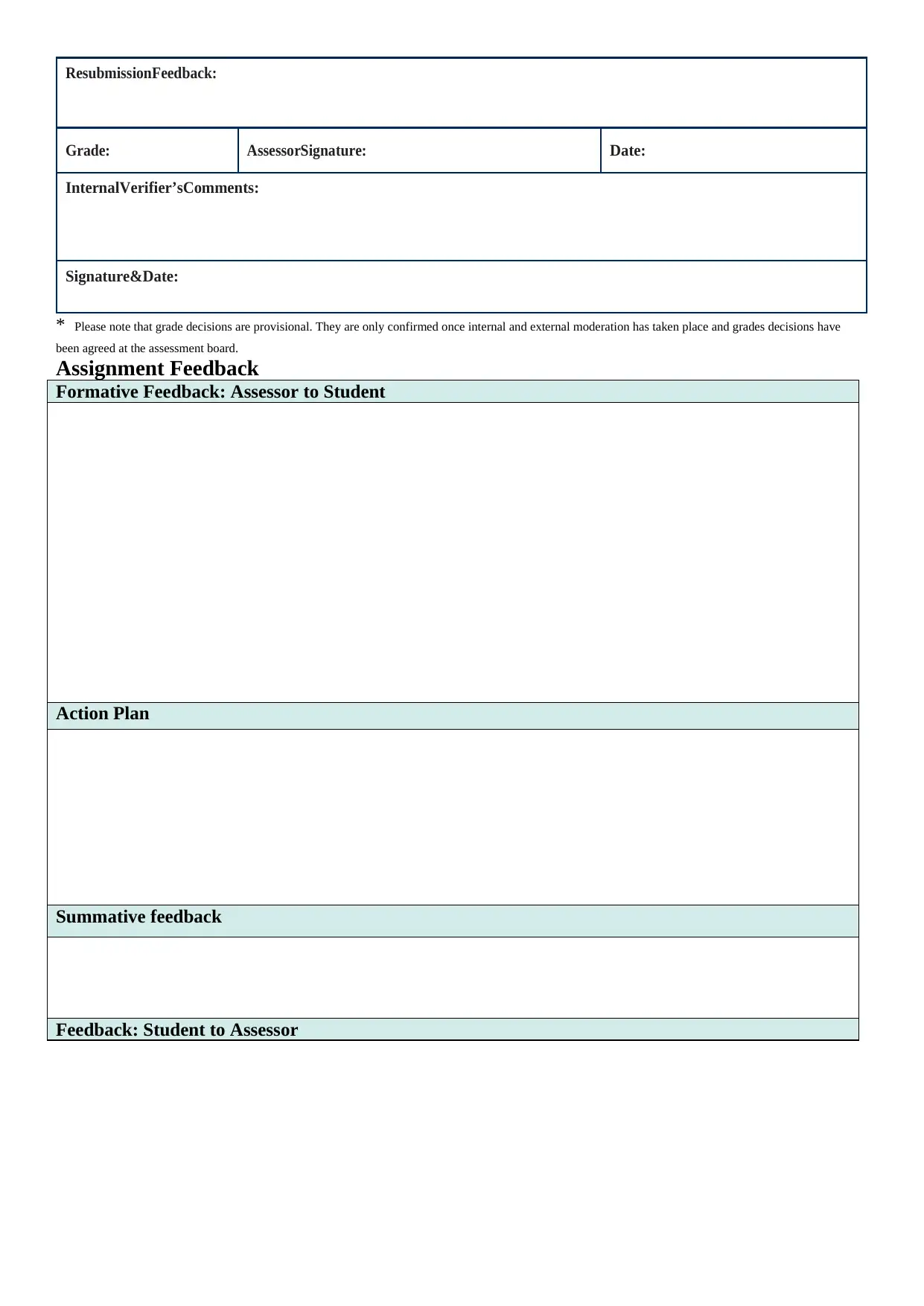
ResubmissionFeedback:
Grade: AssessorSignature: Date:
InternalVerifier’sComments:
Signature&Date:
* Please note that grade decisions are provisional. They are only confirmed once internal and external moderation has taken place and grades decisions have
been agreed at the assessment board.
Assignment Feedback
Formative Feedback: Assessor to Student
Action Plan
Summative feedback
Feedback: Student to Assessor
Grade: AssessorSignature: Date:
InternalVerifier’sComments:
Signature&Date:
* Please note that grade decisions are provisional. They are only confirmed once internal and external moderation has taken place and grades decisions have
been agreed at the assessment board.
Assignment Feedback
Formative Feedback: Assessor to Student
Action Plan
Summative feedback
Feedback: Student to Assessor
Paraphrase This Document
Need a fresh take? Get an instant paraphrase of this document with our AI Paraphraser
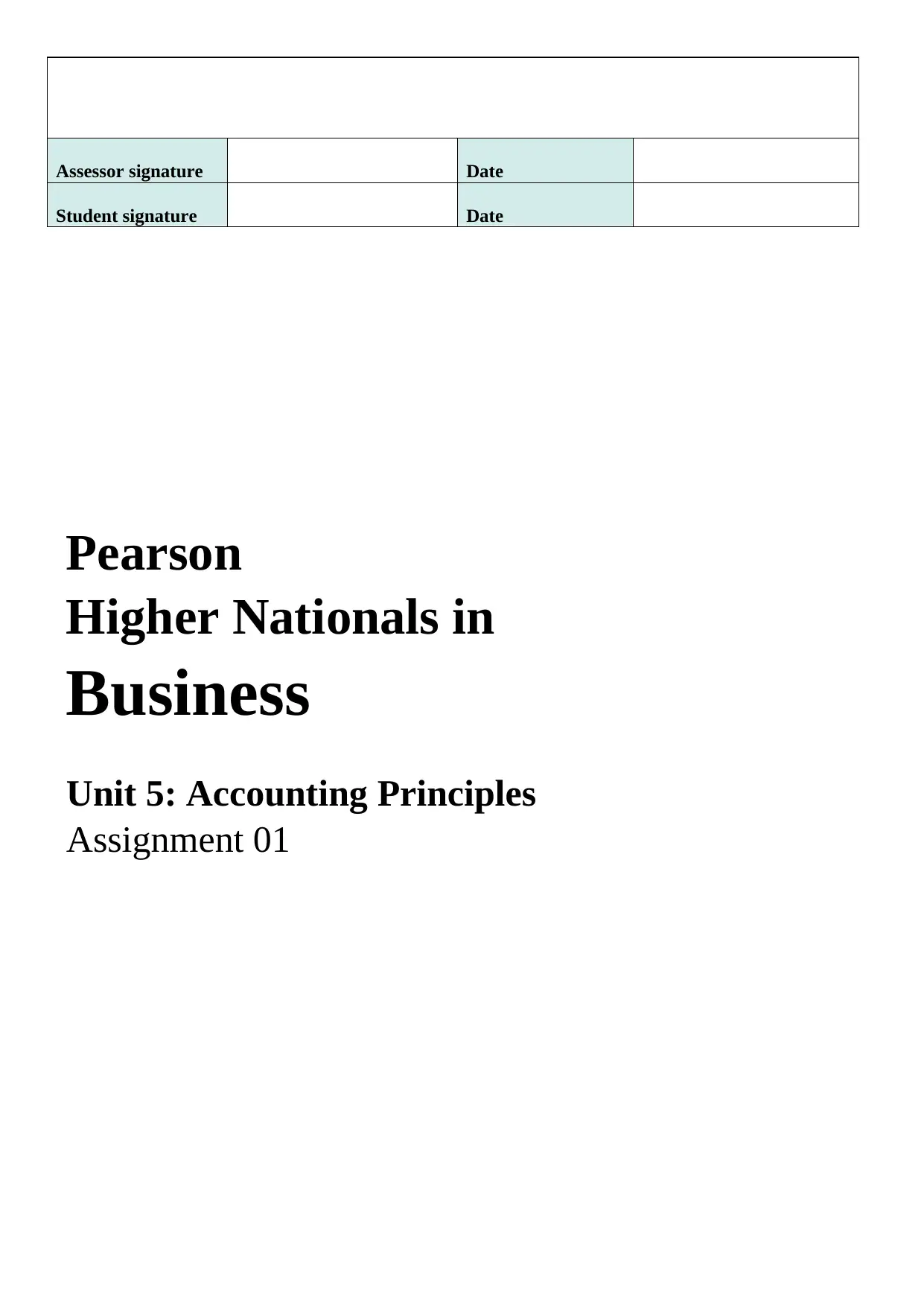
Assessor signature Date
Student signature Date
Pearson
Higher Nationals in
Business
Unit 5: Accounting Principles
Assignment 01
Student signature Date
Pearson
Higher Nationals in
Business
Unit 5: Accounting Principles
Assignment 01
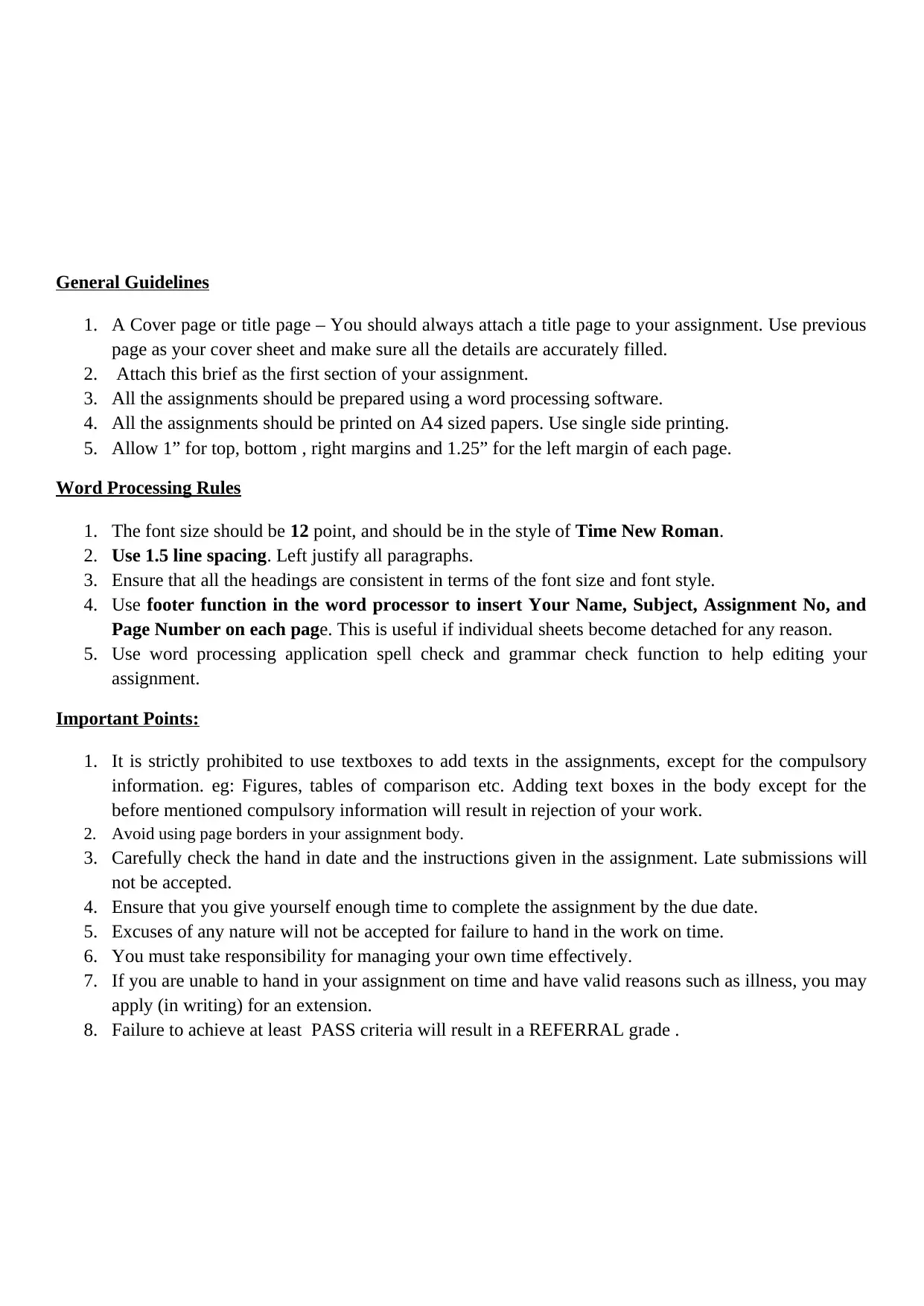
General Guidelines
1. A Cover page or title page – You should always attach a title page to your assignment. Use previous
page as your cover sheet and make sure all the details are accurately filled.
2. Attach this brief as the first section of your assignment.
3. All the assignments should be prepared using a word processing software.
4. All the assignments should be printed on A4 sized papers. Use single side printing.
5. Allow 1” for top, bottom , right margins and 1.25” for the left margin of each page.
Word Processing Rules
1. The font size should be 12 point, and should be in the style of Time New Roman.
2. Use 1.5 line spacing. Left justify all paragraphs.
3. Ensure that all the headings are consistent in terms of the font size and font style.
4. Use footer function in the word processor to insert Your Name, Subject, Assignment No, and
Page Number on each page. This is useful if individual sheets become detached for any reason.
5. Use word processing application spell check and grammar check function to help editing your
assignment.
Important Points:
1. It is strictly prohibited to use textboxes to add texts in the assignments, except for the compulsory
information. eg: Figures, tables of comparison etc. Adding text boxes in the body except for the
before mentioned compulsory information will result in rejection of your work.
2. Avoid using page borders in your assignment body.
3. Carefully check the hand in date and the instructions given in the assignment. Late submissions will
not be accepted.
4. Ensure that you give yourself enough time to complete the assignment by the due date.
5. Excuses of any nature will not be accepted for failure to hand in the work on time.
6. You must take responsibility for managing your own time effectively.
7. If you are unable to hand in your assignment on time and have valid reasons such as illness, you may
apply (in writing) for an extension.
8. Failure to achieve at least PASS criteria will result in a REFERRAL grade .
1. A Cover page or title page – You should always attach a title page to your assignment. Use previous
page as your cover sheet and make sure all the details are accurately filled.
2. Attach this brief as the first section of your assignment.
3. All the assignments should be prepared using a word processing software.
4. All the assignments should be printed on A4 sized papers. Use single side printing.
5. Allow 1” for top, bottom , right margins and 1.25” for the left margin of each page.
Word Processing Rules
1. The font size should be 12 point, and should be in the style of Time New Roman.
2. Use 1.5 line spacing. Left justify all paragraphs.
3. Ensure that all the headings are consistent in terms of the font size and font style.
4. Use footer function in the word processor to insert Your Name, Subject, Assignment No, and
Page Number on each page. This is useful if individual sheets become detached for any reason.
5. Use word processing application spell check and grammar check function to help editing your
assignment.
Important Points:
1. It is strictly prohibited to use textboxes to add texts in the assignments, except for the compulsory
information. eg: Figures, tables of comparison etc. Adding text boxes in the body except for the
before mentioned compulsory information will result in rejection of your work.
2. Avoid using page borders in your assignment body.
3. Carefully check the hand in date and the instructions given in the assignment. Late submissions will
not be accepted.
4. Ensure that you give yourself enough time to complete the assignment by the due date.
5. Excuses of any nature will not be accepted for failure to hand in the work on time.
6. You must take responsibility for managing your own time effectively.
7. If you are unable to hand in your assignment on time and have valid reasons such as illness, you may
apply (in writing) for an extension.
8. Failure to achieve at least PASS criteria will result in a REFERRAL grade .
⊘ This is a preview!⊘
Do you want full access?
Subscribe today to unlock all pages.

Trusted by 1+ million students worldwide
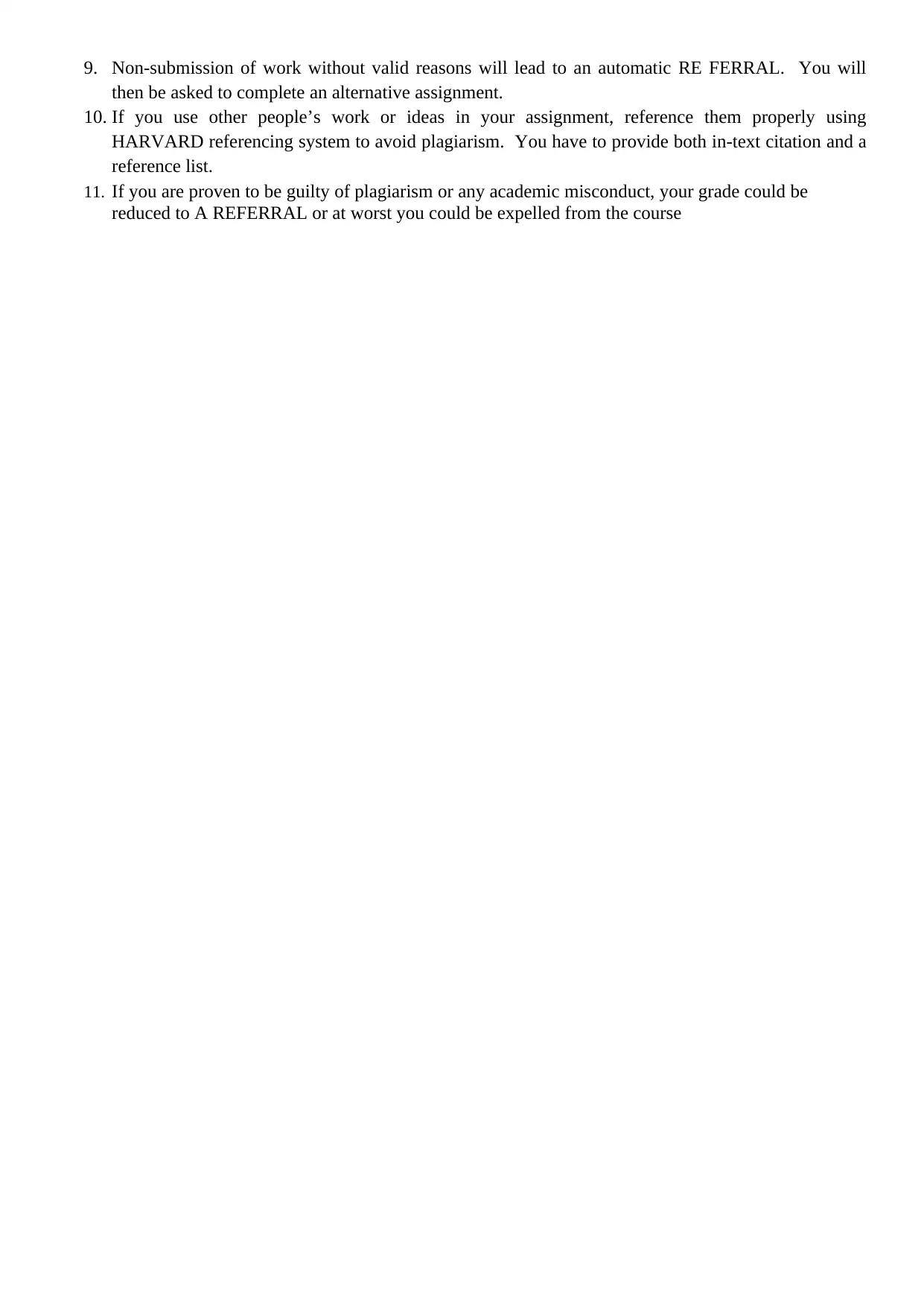
9. Non-submission of work without valid reasons will lead to an automatic RE FERRAL. You will
then be asked to complete an alternative assignment.
10. If you use other people’s work or ideas in your assignment, reference them properly using
HARVARD referencing system to avoid plagiarism. You have to provide both in-text citation and a
reference list.
11. If you are proven to be guilty of plagiarism or any academic misconduct, your grade could be
reduced to A REFERRAL or at worst you could be expelled from the course
then be asked to complete an alternative assignment.
10. If you use other people’s work or ideas in your assignment, reference them properly using
HARVARD referencing system to avoid plagiarism. You have to provide both in-text citation and a
reference list.
11. If you are proven to be guilty of plagiarism or any academic misconduct, your grade could be
reduced to A REFERRAL or at worst you could be expelled from the course
Paraphrase This Document
Need a fresh take? Get an instant paraphrase of this document with our AI Paraphraser
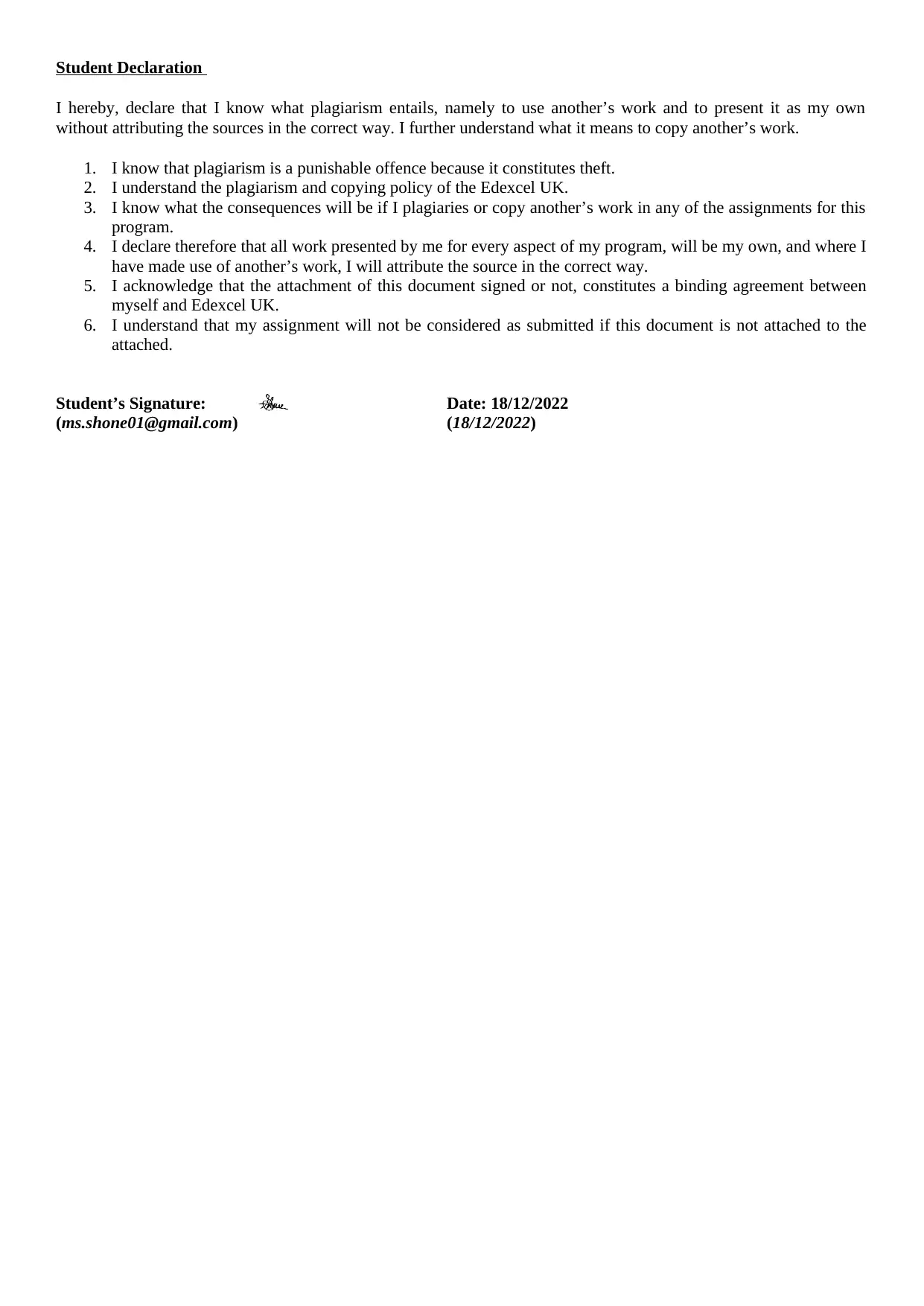
Student Declaration
I hereby, declare that I know what plagiarism entails, namely to use another’s work and to present it as my own
without attributing the sources in the correct way. I further understand what it means to copy another’s work.
1. I know that plagiarism is a punishable offence because it constitutes theft.
2. I understand the plagiarism and copying policy of the Edexcel UK.
3. I know what the consequences will be if I plagiaries or copy another’s work in any of the assignments for this
program.
4. I declare therefore that all work presented by me for every aspect of my program, will be my own, and where I
have made use of another’s work, I will attribute the source in the correct way.
5. I acknowledge that the attachment of this document signed or not, constitutes a binding agreement between
myself and Edexcel UK.
6. I understand that my assignment will not be considered as submitted if this document is not attached to the
attached.
Student’s Signature: Date: 18/12/2022
(ms.shone01@gmail.com) (18/12/2022)
I hereby, declare that I know what plagiarism entails, namely to use another’s work and to present it as my own
without attributing the sources in the correct way. I further understand what it means to copy another’s work.
1. I know that plagiarism is a punishable offence because it constitutes theft.
2. I understand the plagiarism and copying policy of the Edexcel UK.
3. I know what the consequences will be if I plagiaries or copy another’s work in any of the assignments for this
program.
4. I declare therefore that all work presented by me for every aspect of my program, will be my own, and where I
have made use of another’s work, I will attribute the source in the correct way.
5. I acknowledge that the attachment of this document signed or not, constitutes a binding agreement between
myself and Edexcel UK.
6. I understand that my assignment will not be considered as submitted if this document is not attached to the
attached.
Student’s Signature: Date: 18/12/2022
(ms.shone01@gmail.com) (18/12/2022)
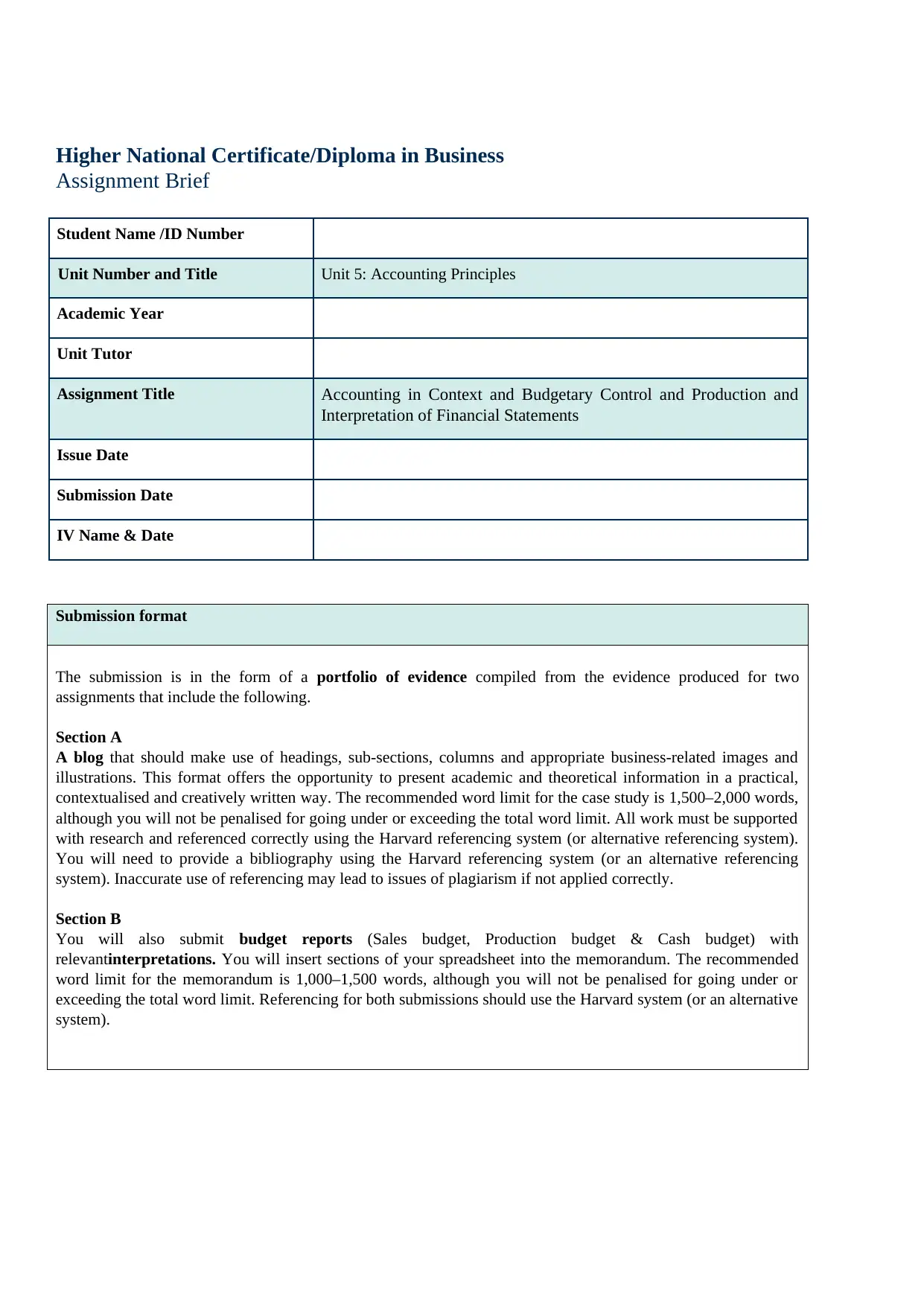
Higher National Certificate/Diploma in Business
Assignment Brief
Student Name /ID Number
Unit Number and Title Unit 5: Accounting Principles
Academic Year
Unit Tutor
Assignment Title Accounting in Context and Budgetary Control and Production and
Interpretation of Financial Statements
Issue Date
Submission Date
IV Name & Date
Submission format
The submission is in the form of a portfolio of evidence compiled from the evidence produced for two
assignments that include the following.
Section A
A blog that should make use of headings, sub-sections, columns and appropriate business-related images and
illustrations. This format offers the opportunity to present academic and theoretical information in a practical,
contextualised and creatively written way. The recommended word limit for the case study is 1,500–2,000 words,
although you will not be penalised for going under or exceeding the total word limit. All work must be supported
with research and referenced correctly using the Harvard referencing system (or alternative referencing system).
You will need to provide a bibliography using the Harvard referencing system (or an alternative referencing
system). Inaccurate use of referencing may lead to issues of plagiarism if not applied correctly.
Section B
You will also submit budget reports (Sales budget, Production budget & Cash budget) with
relevantinterpretations. You will insert sections of your spreadsheet into the memorandum. The recommended
word limit for the memorandum is 1,000–1,500 words, although you will not be penalised for going under or
exceeding the total word limit. Referencing for both submissions should use the Harvard system (or an alternative
system).
Assignment Brief
Student Name /ID Number
Unit Number and Title Unit 5: Accounting Principles
Academic Year
Unit Tutor
Assignment Title Accounting in Context and Budgetary Control and Production and
Interpretation of Financial Statements
Issue Date
Submission Date
IV Name & Date
Submission format
The submission is in the form of a portfolio of evidence compiled from the evidence produced for two
assignments that include the following.
Section A
A blog that should make use of headings, sub-sections, columns and appropriate business-related images and
illustrations. This format offers the opportunity to present academic and theoretical information in a practical,
contextualised and creatively written way. The recommended word limit for the case study is 1,500–2,000 words,
although you will not be penalised for going under or exceeding the total word limit. All work must be supported
with research and referenced correctly using the Harvard referencing system (or alternative referencing system).
You will need to provide a bibliography using the Harvard referencing system (or an alternative referencing
system). Inaccurate use of referencing may lead to issues of plagiarism if not applied correctly.
Section B
You will also submit budget reports (Sales budget, Production budget & Cash budget) with
relevantinterpretations. You will insert sections of your spreadsheet into the memorandum. The recommended
word limit for the memorandum is 1,000–1,500 words, although you will not be penalised for going under or
exceeding the total word limit. Referencing for both submissions should use the Harvard system (or an alternative
system).
⊘ This is a preview!⊘
Do you want full access?
Subscribe today to unlock all pages.

Trusted by 1+ million students worldwide
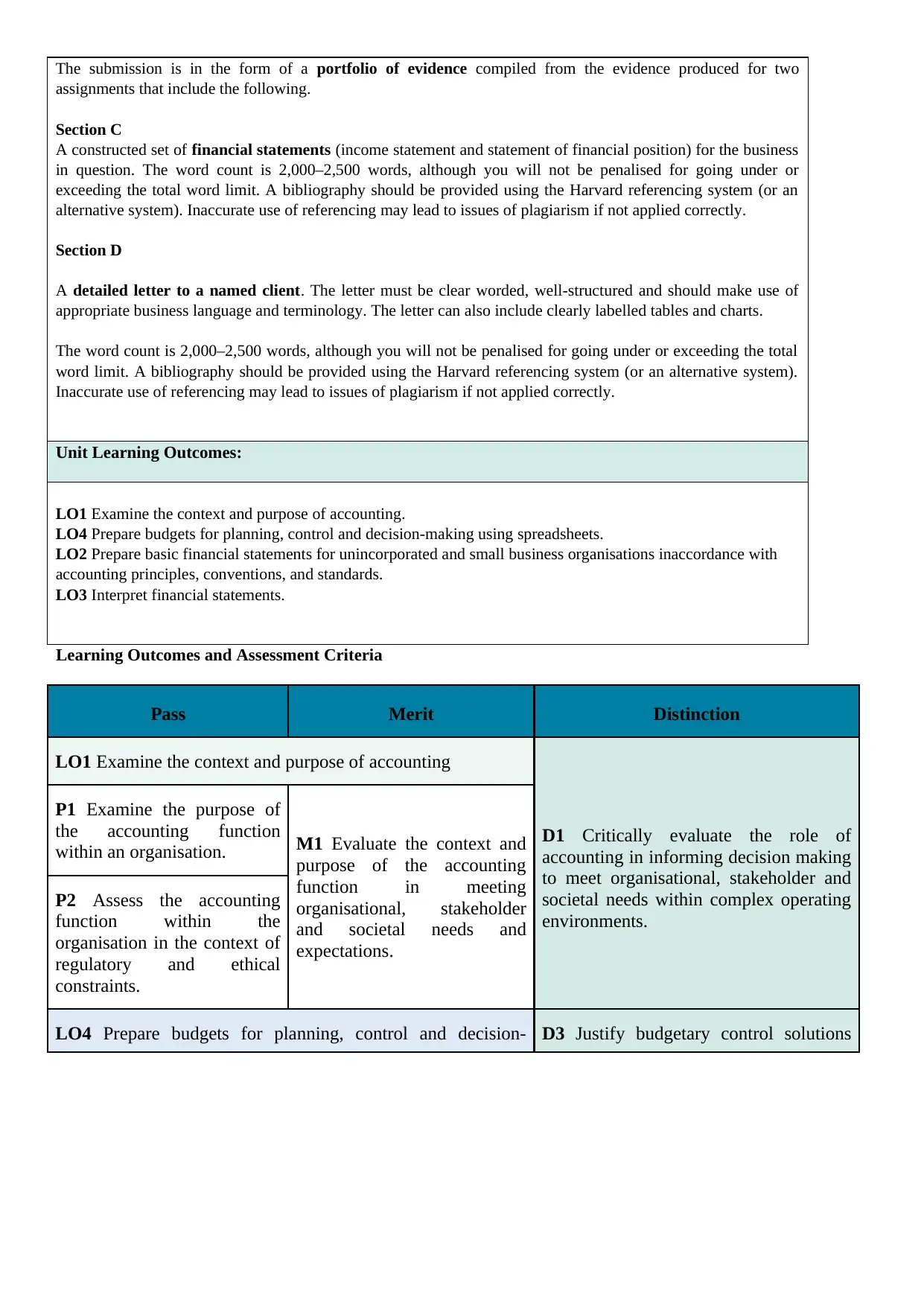
The submission is in the form of a portfolio of evidence compiled from the evidence produced for two
assignments that include the following.
Section C
A constructed set of financial statements (income statement and statement of financial position) for the business
in question. The word count is 2,000–2,500 words, although you will not be penalised for going under or
exceeding the total word limit. A bibliography should be provided using the Harvard referencing system (or an
alternative system). Inaccurate use of referencing may lead to issues of plagiarism if not applied correctly.
Section D
A detailed letter to a named client. The letter must be clear worded, well-structured and should make use of
appropriate business language and terminology. The letter can also include clearly labelled tables and charts.
The word count is 2,000–2,500 words, although you will not be penalised for going under or exceeding the total
word limit. A bibliography should be provided using the Harvard referencing system (or an alternative system).
Inaccurate use of referencing may lead to issues of plagiarism if not applied correctly.
Unit Learning Outcomes:
LO1 Examine the context and purpose of accounting.
LO4 Prepare budgets for planning, control and decision-making using spreadsheets.
LO2 Prepare basic financial statements for unincorporated and small business organisations inaccordance with
accounting principles, conventions, and standards.
LO3 Interpret financial statements.
Learning Outcomes and Assessment Criteria
Pass Merit Distinction
LO1 Examine the context and purpose of accounting
P1 Examine the purpose of
the accounting function
within an organisation. M1 Evaluate the context and
purpose of the accounting
function in meeting
organisational, stakeholder
and societal needs and
expectations.
D1 Critically evaluate the role of
accounting in informing decision making
to meet organisational, stakeholder and
societal needs within complex operating
environments.
P2 Assess the accounting
function within the
organisation in the context of
regulatory and ethical
constraints.
LO4 Prepare budgets for planning, control and decision- D3 Justify budgetary control solutions
assignments that include the following.
Section C
A constructed set of financial statements (income statement and statement of financial position) for the business
in question. The word count is 2,000–2,500 words, although you will not be penalised for going under or
exceeding the total word limit. A bibliography should be provided using the Harvard referencing system (or an
alternative system). Inaccurate use of referencing may lead to issues of plagiarism if not applied correctly.
Section D
A detailed letter to a named client. The letter must be clear worded, well-structured and should make use of
appropriate business language and terminology. The letter can also include clearly labelled tables and charts.
The word count is 2,000–2,500 words, although you will not be penalised for going under or exceeding the total
word limit. A bibliography should be provided using the Harvard referencing system (or an alternative system).
Inaccurate use of referencing may lead to issues of plagiarism if not applied correctly.
Unit Learning Outcomes:
LO1 Examine the context and purpose of accounting.
LO4 Prepare budgets for planning, control and decision-making using spreadsheets.
LO2 Prepare basic financial statements for unincorporated and small business organisations inaccordance with
accounting principles, conventions, and standards.
LO3 Interpret financial statements.
Learning Outcomes and Assessment Criteria
Pass Merit Distinction
LO1 Examine the context and purpose of accounting
P1 Examine the purpose of
the accounting function
within an organisation. M1 Evaluate the context and
purpose of the accounting
function in meeting
organisational, stakeholder
and societal needs and
expectations.
D1 Critically evaluate the role of
accounting in informing decision making
to meet organisational, stakeholder and
societal needs within complex operating
environments.
P2 Assess the accounting
function within the
organisation in the context of
regulatory and ethical
constraints.
LO4 Prepare budgets for planning, control and decision- D3 Justify budgetary control solutions
Paraphrase This Document
Need a fresh take? Get an instant paraphrase of this document with our AI Paraphraser
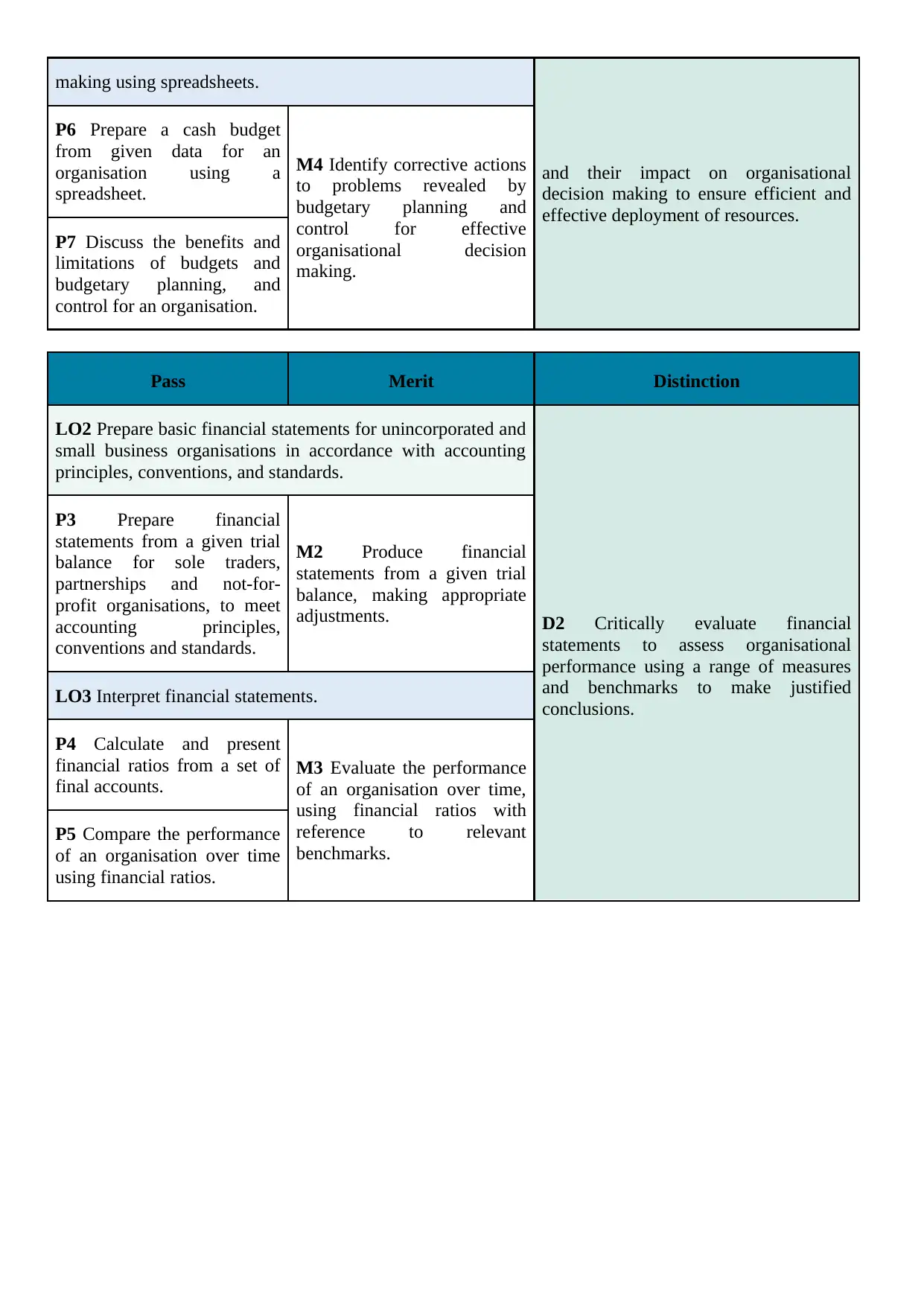
making using spreadsheets.
and their impact on organisational
decision making to ensure efficient and
effective deployment of resources.
P6 Prepare a cash budget
from given data for an
organisation using a
spreadsheet.
M4 Identify corrective actions
to problems revealed by
budgetary planning and
control for effective
organisational decision
making.
P7 Discuss the benefits and
limitations of budgets and
budgetary planning, and
control for an organisation.
Pass Merit Distinction
LO2 Prepare basic financial statements for unincorporated and
small business organisations in accordance with accounting
principles, conventions, and standards.
D2 Critically evaluate financial
statements to assess organisational
performance using a range of measures
and benchmarks to make justified
conclusions.
P3 Prepare financial
statements from a given trial
balance for sole traders,
partnerships and not-for-
profit organisations, to meet
accounting principles,
conventions and standards.
M2 Produce financial
statements from a given trial
balance, making appropriate
adjustments.
LO3 Interpret financial statements.
P4 Calculate and present
financial ratios from a set of
final accounts.
M3 Evaluate the performance
of an organisation over time,
using financial ratios with
reference to relevant
benchmarks.
P5 Compare the performance
of an organisation over time
using financial ratios.
and their impact on organisational
decision making to ensure efficient and
effective deployment of resources.
P6 Prepare a cash budget
from given data for an
organisation using a
spreadsheet.
M4 Identify corrective actions
to problems revealed by
budgetary planning and
control for effective
organisational decision
making.
P7 Discuss the benefits and
limitations of budgets and
budgetary planning, and
control for an organisation.
Pass Merit Distinction
LO2 Prepare basic financial statements for unincorporated and
small business organisations in accordance with accounting
principles, conventions, and standards.
D2 Critically evaluate financial
statements to assess organisational
performance using a range of measures
and benchmarks to make justified
conclusions.
P3 Prepare financial
statements from a given trial
balance for sole traders,
partnerships and not-for-
profit organisations, to meet
accounting principles,
conventions and standards.
M2 Produce financial
statements from a given trial
balance, making appropriate
adjustments.
LO3 Interpret financial statements.
P4 Calculate and present
financial ratios from a set of
final accounts.
M3 Evaluate the performance
of an organisation over time,
using financial ratios with
reference to relevant
benchmarks.
P5 Compare the performance
of an organisation over time
using financial ratios.
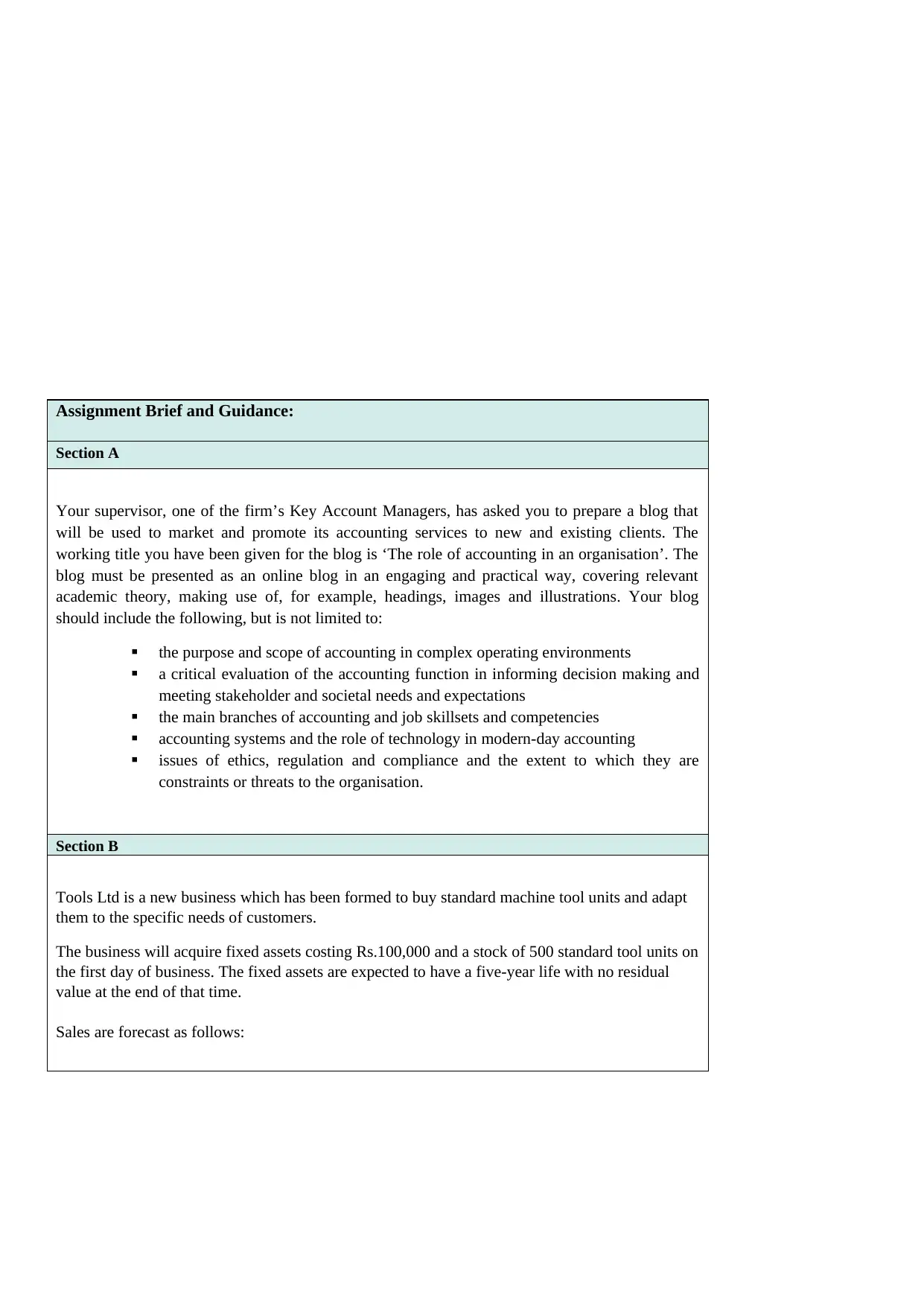
Assignment Brief and Guidance:
Section A
Your supervisor, one of the firm’s Key Account Managers, has asked you to prepare a blog that
will be used to market and promote its accounting services to new and existing clients. The
working title you have been given for the blog is ‘The role of accounting in an organisation’. The
blog must be presented as an online blog in an engaging and practical way, covering relevant
academic theory, making use of, for example, headings, images and illustrations. Your blog
should include the following, but is not limited to:
the purpose and scope of accounting in complex operating environments
a critical evaluation of the accounting function in informing decision making and
meeting stakeholder and societal needs and expectations
the main branches of accounting and job skillsets and competencies
accounting systems and the role of technology in modern-day accounting
issues of ethics, regulation and compliance and the extent to which they are
constraints or threats to the organisation.
Section B
Tools Ltd is a new business which has been formed to buy standard machine tool units and adapt
them to the specific needs of customers.
The business will acquire fixed assets costing Rs.100,000 and a stock of 500 standard tool units on
the first day of business. The fixed assets are expected to have a five-year life with no residual
value at the end of that time.
Sales are forecast as follows:
Section A
Your supervisor, one of the firm’s Key Account Managers, has asked you to prepare a blog that
will be used to market and promote its accounting services to new and existing clients. The
working title you have been given for the blog is ‘The role of accounting in an organisation’. The
blog must be presented as an online blog in an engaging and practical way, covering relevant
academic theory, making use of, for example, headings, images and illustrations. Your blog
should include the following, but is not limited to:
the purpose and scope of accounting in complex operating environments
a critical evaluation of the accounting function in informing decision making and
meeting stakeholder and societal needs and expectations
the main branches of accounting and job skillsets and competencies
accounting systems and the role of technology in modern-day accounting
issues of ethics, regulation and compliance and the extent to which they are
constraints or threats to the organisation.
Section B
Tools Ltd is a new business which has been formed to buy standard machine tool units and adapt
them to the specific needs of customers.
The business will acquire fixed assets costing Rs.100,000 and a stock of 500 standard tool units on
the first day of business. The fixed assets are expected to have a five-year life with no residual
value at the end of that time.
Sales are forecast as follows:
⊘ This is a preview!⊘
Do you want full access?
Subscribe today to unlock all pages.

Trusted by 1+ million students worldwide
1 out of 32
Related Documents
Your All-in-One AI-Powered Toolkit for Academic Success.
+13062052269
info@desklib.com
Available 24*7 on WhatsApp / Email
![[object Object]](/_next/static/media/star-bottom.7253800d.svg)
Unlock your academic potential
Copyright © 2020–2025 A2Z Services. All Rights Reserved. Developed and managed by ZUCOL.





